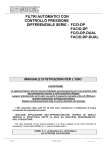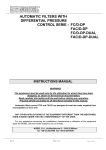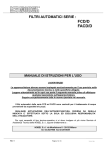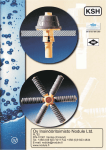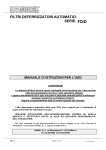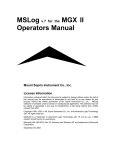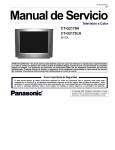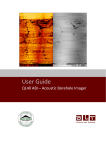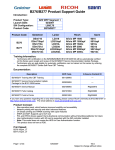Download NobelCom Automatic Filter Series FAC/D User's Manual
Transcript
AUTOMATIC FILTERS SERIES: FC/D FAC/D INSTRUCTIONS MANUAL WARNING! The equipment must be used only for the utilization for which they have been designed, as shown in the technical documentation. Read carefully this leaflet until the end before starting any operation. Proceed strictly according to all directions included in this manual. Automatic filters series FC/D and FAC/D are designed to treat raw water supplied from municipalities or from well. ANY OTHER APPLICATIONS OF THE EQUIPMENT DIFFERENT THAN THE MENTIONED ONES IS MADE UNDER THE ONLY RESPONSIBILITY OF THE USER. For any assistance concerning the installations, maintenance or utilization of the equipment apply the NOBEL Service Center closest to you or directly: NOBEL S.r.l. via Monfalcone 8 - 20132 Milano tel. +39 02 2827968 fax +39 02 2610839 REV.1 Page 1 of 14 p11.02-v34.f fcd_mi-r1.doc AUTOMATIC FILTERS INSTRUCTIONS MANUAL FC/D - FAC/D INDEX 1. Safety.......................................................................................................................................3 1.1. General ...............................................................................................................................3 1.2. How to displace the unit ......................................................................................................3 1.3. Hydraulics ...........................................................................................................................3 1.4. Electrical..............................................................................................................................3 1.5. How to store and delivery....................................................................................................3 2. Principles of working................................................................................................................4 2.1. Quartz-sand filters FC/D .....................................................................................................4 2.2. Activated-carbon filters FAC/D............................................................................................4 3. Technical characteristics .........................................................................................................5 3.1. Assumed raw water characteristics.....................................................................................5 3.2. Technical characteristics (general) .....................................................................................5 3.3. Characteristics for each model............................................................................................5 3.4. Dimensions .........................................................................................................................6 3.5. Weight .................................................................................................................................6 4. Installation................................................................................................................................7 4.1. Room conditions .................................................................................................................7 4.2. How to remove packaging...................................................................................................7 4.3. How to move and lift the unit...............................................................................................8 4.4. Placing & commissioning ....................................................................................................8 4.5. Hydraulic connections .........................................................................................................9 4.6. Electrical wiring connections ...............................................................................................9 5. End cycle and regeneration ...................................................................................................10 5.1. End cycle...........................................................................................................................10 5.2. Regeneration.....................................................................................................................10 5.3. How to set the time of regeneration ..................................................................................11 6. Starting-up .............................................................................................................................11 7. Service & maintenance..........................................................................................................12 7.1. Disposal ............................................................................................................................12 8. Main components ..................................................................................................................13 9. Trouble shooting guide ..........................................................................................................14 Annex DRAWING 1: dimensions DRAWING 2: components models FC05/D÷FC11/D, FAC05/D÷ FAC11/D DRAWING 3: components models FC15/D÷FC80/D, FAC15/D÷FAC60/D DRAWING 4: installation models FC05/D÷FC11/D, FAC05/D÷ FAC11/D DRAWING 5: installation models FC15/D÷FC80/D, FAC15/D÷FAC60/D Special instructions membrane valves Special instructions electronic programmer s.r.l.Milano - ITALY Page 2 of 14 p11.02-v34.f fcd_mi-r1.doc AUTOMATIC FILTERS INSTRUCTIONS MANUAL FC/D - FAC/D 1. Safety 1.1. General The equipment has been designed and constructed according to D.P.R. n° 459 of 24th July 1996 (regulation for accomplishment of Norms 89/392/CEE, 91/368/CEE, 93/44/CEE and 93/68/CEE regarding the unification of States members laws in so far as machines are concerned). It has been designed and constructed according to European Norms UNI EN 292-1, UNI EN 292-2, UNI EN 292-2/A1, UNI EN 983, CEI EN 60439-1, CEI EN 60 204-1. Only authorized and skilled personnel will be allowed to carry out installation, start up as well as routine and planned maintenance. 1.2. How to displace the unit Particular care and attention should be put in during moving and displacing of heavy items, in order to avoid injuries to persons or damage properties. The heavy parts must be lifted and displaced always hooking and lifting them by the points shown on the drawings (see fig. 1) and using only suitable ropes, hooks and/or chains, according to the weight (see weight table § 3.5 page 6). 1.3. Hydraulics All operations must be performed by and/or under direct supervision of skilled and authorized operators, using proper tools and personal protection devices if required (CE marked). Before any operation of taking out pipes or part of hydraulic system, it is required to release the pressure inside and empty the part of the system. 1.4. Electrical Before starting any operation on electrical devices, be sure that main power supply is OFF. All operations must be performed by skilled and authorized operators. In case of liquid leakage, switch off the main power supply before operate. Before the switching ON, be sure all the parts of the system are perfectly dry. Check that the available electrical power is correct, (see § 3.2 page 5) before connection. Do not make preliminary wiring connections. 1.5. How to store and delivery = ºC • closed rooms • open space • transport 5÷45 5÷45 5÷45 t = ºF humidity rel. 41÷113 5÷95% without condensate 41÷113 5÷95% without condensate 41÷113 5÷95% without condensate notes protect from sun-light and rain. protect from sun-light and rain. s.r.l.Milano - ITALY Page 3 of 14 p11.02-v34.f fcd_mi-r1.doc AUTOMATIC FILTERS INSTRUCTIONS MANUAL FC/D - FAC/D 2. Principles of working FC/D and FAC/D series filters are used for water treatment for residential and industrial applications as well. All the materials are food grade and approved for drinking water. 2.1. Quartz-sand filters FC/D The filtration through a sand media is a mechanical process that allows to remove suspended solids (even of small dimensions) from water. The slower is the linear flow (speed of water trough the filtering bed), the better is the filtration action. During the process, as the filtering bed traps the suspended particles, as filtration action increases, since the trapped solids works the same way of a filtering bed! But it also increases the resistance of the filtering bed against the water flow; so the pressure drop between inlet and outlet increases as well. The maximum allowed pressure drop is 1 bar (100 kPa), after that it is required to backwash the filtering bed. The purpose of the backwashing is to re-built the filtering bed efficiency, by removing the solids trapped during service; it is featured by a counter-flow of water through the filtering bed. The working of the system is controlled by an automatic programmer, allowing to schedule the day and the hour of the regeneration (backwashing). For the best working of the filter, the backwashing should be featured before the pressure drop reaches the threshold level (1 bar - 100 kPa). According to that, it is suggested to schedule the regeneration according to a pressure drop of 0.6÷0.7 bar (60÷70 kPa). During regeneration the water supplying is completely inhibited by means of a membrane valve mounted on the outlet line. 2.2. Activated-carbon filters FAC/D Filtration through a bed of activated carbon is the process that allows to remove organic matters and chlorine from water. The lower is the flow rate, the better is the filtration action. FAC/D series filters are designed and sized for chlorine removal. The expected life of activated-carbon used as de-chlorination (chlorine removal) is very long; it works as chemical reduction of chlorine to chloride ion. Activated carbon action is not selective in removing the substances contained in water and crossing the filtering bed: hence, it removes also the organics the water contains, if any. Therefore, it could happen that the filtering bed is exhausted or clogged by the trapping of substances contained in water, even if the purpose of treatment was not the removal of these substances, but just the de-chlorination. Furthermore, it could happen that the filtering bed releases some of the substances previously trapped in higher concentration than before. Since it is quite impossible to forecast the exhaustion of the activated carbon bed, or to monitor the exhaustion itself, with current instrumentation, the utilization of an activated carbon filter must be strictly avoided without adequate pre-treatments, like quartz-sand filtration, chlorination, etc. s.r.l.Milano - ITALY Page 4 of 14 p11.02-v34.f fcd_mi-r1.doc AUTOMATIC FILTERS INSTRUCTIONS MANUAL FC/D - FAC/D Whether raw water contains organics and/or is biologically polluted, FAC/D series filters CANNOT be used without written authorization by NOBEL Technical Department. The activated-carbon bed also works as a mechanic filter same way of quartz-sand bed. Although this working should be avoided, it can happen that the pressure drop of activatedcarbon bed reaches a value of 1 bar (100 kPa); in this case the backwashing of the filtering bed is required. The equipment allows to schedule the days (how often) and time of day for the regeneration, same way of quartz-sand filters, as above explained. It is recommended to run the regeneration only when it is strictly required: the backwashing causes the mixing of the bed and could displace the higher layers of activated carbon (most polluted) from the top to the bottom of the column. During regeneration the water supplying is completely inhibited by means of a membrane valve mounted on the outlet line. 3. Technical characteristics 3.1. Assumed raw water characteristics • water temperature (min÷max) • water pressure (min÷max) 3.2. V ph/Hz W min. bar (kPa) 230 1/50 50 20÷30 0.2÷1.0 (20÷100) Characteristics for each model connections MODEL FC05/D FC08/D FC11/D FC15/D FC20/D FC25/D FC30/D FC40/D FC45/D FC50/D FC60/D FC70/D FC80/D 5÷40 (41÷104) 1.5÷8.0 (150÷800) Technical characteristics (general) • power supply • regeneration time • ∆p min/max 3.3. ºC (ºF) bar (kPa) backwashing water consumption flow m³/h IN/OUT drain operating 1¼" 1½" 1½" 2" 2" 2½" DN80 DN80 DN80 DN100 DN100 DN100 DN100 1" 1¼" 1¼" 1½" 1½" 2" 2½" 2½" 2½" DN80 DN80 DN80 DN80 3.2 4.0 5.7 7.8 10.0 13.0 16.0 20.0 23.0 27.0 31.0 35.0 40.0 max backwash liters 6.5 8.0 11.0 15.0 20.0 26.0 32.0 40.0 46.0 53.0 62.0 70.0 80.0 4.8 6.0 8.5 11.0 15.0 20.0 24.0 30.0 35.0 40.0 46.0 53.0 60.0 1600 2000 2850 3900 5000 6500 8000 10000 11500 13500 15500 17500 20000 s.r.l.Milano - ITALY Page 5 of 14 p11.02-v34.f fcd_mi-r1.doc AUTOMATIC FILTERS INSTRUCTIONS MANUAL FC/D - FAC/D connections MODEL FAC05/D FAC08/D FAC11/D FAC15/D FAC20/D FAC25/D FAC30/D FAC40/D FAC50/D FAC60/D 3.4. flow m³/h IN/OUT drain max backwash 1¼" 1½" 1½" 2" 2½" 2½" DN80 DN80 DN100 DN100 1" 1¼" 1¼" 1½" 2" 2" 2½" 2½" DN80 DN80 5.0 8.0 11.0 15.0 20.0 24.0 30.0 40.0 48.0 61.0 5.0 8.0 11.0 15.0 20.0 24.0 30.0 40.0 48.0 61.0 backwashing water consumption liters 500 800 1100 1500 2000 2400 3000 4000 4800 6100 Dimensions See DRAWING 1 dimensions 3.5. Weight WEIGHT MODEL FC05/D FC08/D FC11/D FC15/D FC20/D FC25/D FC30/D FC40/D FC45/D FC50/D FC60/D FC70/D FC80/D vessel quartz-sand kg on service kg 04÷07 mm 1÷2 mm 2÷3 mm anthracite l (kg) shipping approx. kg approx. kg 140 155 185 300 340 390 435 550 610 670 740 870 1100 100 120 200 250 300 400 500 600 700 800 900 1100 1250 50 60 80 100 150 200 200 300 350 400 450 500 600 35 50 50 100 100 150 200 200 250 300 350 400 450 40(40) 50(50) 70(70) 100(100 130(130 150(150) 200(200) 250(250) 300(300) 350(350) 400(400) 450(450) 500(500) 400 470 620 900 1100 1350 1650 2000 2350 2750 3100 3500 4000 600 700 960 1400 1700 2100 2600 3200 3700 4500 5000 5600 6400 s.r.l.Milano - ITALY Page 6 of 14 p8.04-v36.f fcd_mi-r1.doc AUTOMATIC FILTERS INSTRUCTIONS MANUAL FC/D - FAC/D WEIGHT MODEL FAC05/D FAC08/D FAC11/D FAC15/D FAC20/D FAC25/D FAC30/D FAC40/D FAC50/D FAC60/D 4. vessel quartz-sand 1-2 mm kg kg activated carbon l (kg) 155 185 300 340 390 435 550 670 740 1100 30 50 50 75 100 100 150 200 250 300 200(96) 280(134) 350(168) 500(240) 650(312) 800(463) 1000(480) 1350(648) 1600(768) 2000(960) on service shipping approx. kg approx. kg 320 410 560 710 900 1000 1300 1650 2000 2600 550 750 1100 1300 1700 1900 2400 3200 3800 5000 Installation 4.1. Room conditions Room & climate conditions. • • • • room temperature humidity rel. sun-light rain, snow etc. 4.2. 5÷45ºC (41÷113ºF) 5÷95 % without condensate protection required protection required How to remove packaging The vessels are shipped wrapped in a plastic foil; remove it with care before starting-up. Keep the cards and everything contained inside the packaging. The media filter are shipped as separated: • in bags of 25 kg (35 liters) each or fraction anthracite • in bags of 50 kg each or fraction quartz sand • in bags of 25 kg (50 liters approx.) each or fraction activated carbon s.r.l.Milano - ITALY Page 7 of 14 p8.04-v36.f fcd_mi-r1.doc AUTOMATIC FILTERS INSTRUCTIONS MANUAL FC/D - FAC/D 4.3. How to move and lift the unit The vessels can be displaced when they are empty, hooking and lifting by the special rings mounted on the upper part of the vessels (see fig. 1). It is recommended to use proper sized hooks and ropes, according to the weight. It is also possible to hook and lift the vessel by the bearing legs. GOLFARI HOOKING CAUTION : DO NOT LIFT OR MOVE THE UNIT HOOKING OR CATCHING BY THE PRE-ASSEMBLED PARTS. GAMBE DI SOSTEGNO LEGS Figure A 4.4. Placing & commissioning Place the unit according to the available room of the site and the required room for current maintenance and service of the equipment. See the dimensional drawing. • Place the column on a perfectly flat surface. The position shown on the installation drawing is only suggested; the column can be placed in different positions, according to the inlet/outlet connections on the valve group. • Load the supplied quartz-sand (2-3 mm size for FC/D filters, 1-2 mm size for FAC/D filters) into the vessel, through the lower man-hole, until the sand covers completely the filternozzles. Make a flat surface of the sand using a wooden tool, in order to avoid any damage to the coating of the vessel. Close the man-hole tightening the nuts. • Load the rest of supplied media filter into the vessel, through the upper man-hole (or through the upper head, see components drawing). The media filter are shipped separately; check that the shipped and available quantity complies exactly with the quantity listed in the Weight Table (§ 3.5 page 6). Filtering media must be loaded, one after the other one, and according to the following order: ◊ quartz sand 2÷3 mm (only for filters FC) ◊ quartz sand 1÷2 mm ◊ quartz sand 0.4÷0.7 mm (only for filters FC) ◊ anthracite (only for filters FC) ◊ activated carbon (only for filters FAC) • After completed the loading, close the upper man-hole (or upper head) • Fix the group with membrane valves to the column (if separately shipped, see installation drawing) s.r.l.Milano - ITALY Page 8 of 14 p11.02-v34.f fcd_mi-r1.doc AUTOMATIC FILTERS INSTRUCTIONS MANUAL FC/D - FAC/D 4.5. Hydraulic connections In order to avoid shut-off during maintenance operations, an emergency by-pass line should be provided • Complete the line from inlet fittings to the raw water line. • Complete the line from outlet fittings (valve V2) to the treated water line. • Connect the drain valves (V1 and V5) to a floor drain. The gate valve mounted downstream of the valve V5 will be used to adjust the backwash flow rate. A common flexible pipe made in plastic or rubber can be used for the drain line; its diameter must be of at least one size larger of the one mentioned on “CHARACTERISTICS FOR EACH MODEL” table. It is suggested the drain line could be inspected in order to check quantity and quality of drain water, as well as any leakage of media filter from the unit. • Connect the inlet air fitting, placed on the base manifold of the solenoyd valves, to a compressed air-mains, complete with pressure reducer, dehumidifier filter and shut-off valve. The air pressure must be kept at value equal or higher of the pressure of water to be treated, with max value of 8.0 bar. Whether water is used to pilot the valves, the inlet fitting of the base manifold of the solenoyd valves must be connected to the pilot water fitting (¼"), pre-arranged on the inlet manifold of the column; run to the drain a pipe from the drain fitting (¼") of the base manifold of the solenoyd valves. • Complete the line between the outlet fitting of each solenoyd valve to the correspondent membrane valve: SOLENOYD VALVE EV no. TYPE 1 NC 2 NC 3 NC MEMBRANE VALVES no. TYPE V1 NC V2 NA V3-V4-V5 NC-NA-NC All the solenoyd valves can be hand-driven by the lever placed at the base of each of them; the turning of the lever simulate the action of the coil. Then, for valves NC type, the valve is closed when the lever is on parallel to the base; it is opened when the lever is on perpendicular to the base itself. 4.6. Electrical wiring connections • Connect the power cable of the programmer to a power socket check that the available power is correct as listed in technical characteristics (see § 3.2 page 5). • The relais R, available upon request, allows to have a free voltage contact for remote segnalation of running regeneration; the wiring connection must be done directly on the clamps of NO contact on the relais itself. s.r.l.Milano - ITALY Page 9 of 14 p11.02-v34.f fcd_mi-r1.doc AUTOMATIC FILTERS INSTRUCTIONS MANUAL FC/D - FAC/D 5. End cycle and regeneration 5.1. End cycle The adjustment of the end cycle depends on the quantity of suspended solids the water contains. Take note of the parameters to be taken in consideration, as below listed, since a correct adjustment can be made only checking the real operating conditions. The end of a cycle is reached when the pressure drop across the filter is approx. 0.8÷1.0 bar (80÷100 kPa). After checked after how long time the max allowable pressure drop is reached, it is possible to adjust the time schedule of the regeneration definitely. The filters are equipped with an electronic time programmer that allows to schedule the automatic regeneration: it starts at selected time and day (24 h, 7 days). 5.2. Regeneration The regeneration is automatically controlled; it can also be started manually, at any time. The manual start of a regeneration can be made by a proper sequence of pushing the buttons 1 and 2 placed on the programmer, in order to act the relays of the channels 1 and 2. During the operation, the power must be ON. When the regeneration, manually started, is completed, the unit will go on to work according to the pre-set schedule. The regeneration can also run in case of power failure, by hand-driving the lever of the pilot solenoyd valves: the solenoyd valve is closed when the lever is on parallel to the base and it is open when it is on perpendicular to the base itself. Naturally, the compressed air supplying (air controlled valves) or pilot water supplying (water controlled valves) must be assured. The correspondent membrane valves (controlled by the pilot solenoyd ones), if NC type is open when the solenoyd valve is open, and viceversa if the membrane valve is NO type. PHASE SERVICE BACKWASHING RINSE SOLENOYD VALVES EXCITED (=OPEN) // E2 - E3 E1 - E2 OPEN VALVES V2 - V4 V3 - V5 V1 - V4 The regeneration phases run one after another, as follows : 1. Backwash : during this phase, the water flushes from the bottom to the top of the column, lifting the filtering media and releasing the solids trapped on its surface during the service. The backwashing water flows to drain from the top of the column. This is the only phase, during which the water crosses through the column from the bottom to the top. 2. Rinse : it is the phase during which the filtering media are rinsed; at the end of this phase the column is ready to start again a new service cycle. NOTE: During regeneration the water supplying is completely inhibited by means of a membrane valve mounted on the outlet line. s.r.l.Milano - ITALY Page 10 of 14 p11.02-v34.f fcd_mi-r1.doc AUTOMATIC FILTERS INSTRUCTIONS MANUAL FC/D - FAC/D 5.3. How to set the time of regeneration The electronic programmer keep in memory the program by mean of an EEPROM; the time of the day is memorized even in case of power failure (internal not-rechargeable buffer battery, charge life max 5 years without power). The setting or modification of the factory set values, shown on table below, is very easy. Just take note that the start of backwashing phase is controlled by the exciting of channel 1, the starting of the rinse phase by the exciting of channel 2, the end of rinse phase (therefore the end of regeneration) by the elapsed time pre-set for channel 1. For any informations concerning how to operate and modify, see attached special instructions of the programmer. FACTORY SET FOR FC FILTERS (regeneration once a day) start of backwash channel 1 channel 2 end of backwash start of rinse ON 23.00 end of rinse at rest position of CH2 OFF 23.25 ON 23.20 OFF 23.30 FACTORY SET FOR FAC FILTERS (regeneration once a week) start of backwash channel 1 channel 2 6. end of backwash start of rinse ON 23.00 end of rinse at rest position of CH2 OFF 23.15 ON 23.10 OFF 23.30 Starting-up The starting-up of the unit consists of running a first regeneration cycle, during which the filtering media column will be filled of water, all automatic features will be checked and the unit will be prepared to start the service. At the beginning, it is suggested to operate manually, hand-driven the valves, as above explained at the § "Regeneration". This way will allow to stop, to run for longer time or to repeat each phase as desired. To start-up the unit, proceed as follows : • • • • • • • • • • • DISCONNECT ELECTRIC POWER Open the by-pass and inlet valves, keeping the outlet one shut. close the gate valve along the backwash drain line hand-drive the solenoyd valves E3 to open the backwashing membrane valves open slowly and gradually the gate valve on backwash drain line. The water will enter inside the vessel from the bottom and, during filling, will expel the air inside it. when only water will come out from the drain, adjust the drain valve in order that the flow rate will be the highest allowable without any leakage of media filter through the drain line; when the proper flow rate of backwash has been stated, adjust the gate valve definitely. The backwashing phase must run until all the water coming out the drain is perfectly clear. Hand-drive the solenoyd valves E3 to close the backwashing membrane valves. Hand-drive the solenoyd valve E1 to open the membrane valve V1 (RINSE); the rinse phase must run until all the water coming out the drain is perfectly clear. Hand-drive the solenoyd valves E1 to close the valve V1 and to conclude the regeneration. Switch ON the control panel. Open the outlet valve and close the by-pass valve. Starting now the unit is on service and feeds treated water. s.r.l.Milano - ITALY Page 11 of 14 p11.02-v34.f fcd_mi-r1.doc AUTOMATIC FILTERS INSTRUCTIONS MANUAL FC/D - FAC/D 7. Service & maintenance Automatic filters are equipment designed to treat raw water supplied from municipalities or from well. ANY OTHER APPLICATIONS OF THE EQUIPMENT DIFFERENT THAN THE MENTIONED ONES IS MADE UNDER THE ONLY RESPONSIBILITY OF THE USER. The correct handling of the equipment requires : • check that the air and/or water pressure are within the stated values. Not any further special maintenance operations are required. There is not any consumption material to be currently replaced. The average life of the filter-bed is approx. 5÷8 years, according to the quality of raw water and how often regeneration is featured. 7.1. Disposal In case of disposal of the unit or parts of it, it must be made according to local laws concerning the waste of the materials. Concerning media filter, they are natural products that, at origin state, can be disposed of as natural products. Whether the activated carbon had trapped special and particular substances, the carbon will be classified as same class of the trapped substances. To dispose of them it should be required to identify the class of this waste, by a detailed analysis. s.r.l.Milano - ITALY Page 12 of 14 p11.02-v34.f fcd_mi-r1.doc AUTOMATIC FILTERS INSTRUCTIONS MANUAL FC/D - FAC/D 8. Main components Quantity 1 1 # 5 3 1 # DESCRIPTION vessel in coated carbon steel (see table DIMENSIONS) internal water distribution system (see following table) filtering media (see table WEIGHT) membrane valves made in cast-iron (see following table) pilot solenoyd valves TYPE_______ electronic programmer type VEMER LOGIK DW2 galvanized steel fittings several size membrane valves V1 V2 V3 V4 V5 number/type 1"NC 1¼"NA 1"NC 1¼"NA 1"NC 12 short 1"NC 1½"NA 1¼"NC 1½"NA 1¼"NC 12 short 1"NC 1½"NA 1¼"NC 1½"NA 1¼"NC 18 short 1"NC 2"NA 1½"NC 2"NA 1½"NC 30 plate 1"NC 2"NA 1½"NC 2"NA 1½"NC 36 plate MODEL FC05/D FC08/D FC11/D FC15/D FC20/D FC25/D FC30/D FC40/D FC45/D FC50/D FC60/D FC70/D FC80/D distribution system 1"NC 2½"NA 2"NC 2½"NA 2"NC 42 plate 1¼"NC DN80NA 2½"NC DN80NA 2½"NC 56 plate 1¼"NC DN80NA 2½"NC DN80NA 2½"NC 68 plate 1¼"NC DN80NA 2½"NC DN80NA 2½"NC 84 plate 1½"NC DN100NA DN80NC DN100NA DN80NC 87 plate 1½"NC DN100NA DN80NC DN100NA DN80NC 104 plate 1½"NC DN100NA DN80NC DN100NA DN80NC 118 plate 1½"NC DN100NA DN80NC DN100NA DN80NC 142 plate membrane valves V1 V2 1"NC 1¼"NA 1"NC 1¼"NA 1"NC 12 short 1"NC 1½"NA 1¼"NC 1½"NA 1¼"NC 18 short 1"NC 1½"NA 1¼"NC 1½"NA 1¼"NC 30 plate 1"NC 2"NA 1½"NC 2"NA 1½"NC 36 plate 1"NC 2½"NA 2"NC 2½"NA 2"NC 42 plate 1"NC 2½"NA 2"NC 2½"NA 2"NC 56 plate 1¼"NC DN80NA 2½"NC DN80NA 2½"NC 68 plate MODEL FAC05/D FAC08/D FAC11/D FAC15/D FAC20/D FAC25/D FAC30/D FAC40/D FAC50/D FAC60/D V3 distribution system V4 V5 number/type 1¼"NC DN80NA 2½"NC DN80NA 2½"NC 87 plate 1½"NC DN100NA DN80NC DN100NA DN80NC 104 plate 1½"NC DN100NA DN80NC DN100NA DN80NC 142 plate s.r.l.Milano - ITALY Page 13 of 14 p11.02-v34.f fcd_mi-r1.doc AUTOMATIC FILTERS INSTRUCTIONS MANUAL FC/D - FAC/D 9. Trouble shooting guide PROBLEM CAUSE HOW TO SOLVE • connect electrical power • The electronic programmer does not • electrical power is disconnected switch ON. • replace the programmer • the programmer is defected • connect electrical power • The regeneration does not run • electrical power is disconnected • adjust correctly the programmer • the programmer is not correctly adjusted • replace the programmer • the programmer is defected • connect properly the supplying of pilot water or • Regeneration is electrically started • there is not supplying of pilot fluid (air or water) compressed air but it does not run hydraulically • replace the defected solenoyd valves • one or more solenoyd valves are defected • There is a leakage of water to drain • one or both membrane valves no. 1 and 5 do not • check the proper working of the pilot solenoyd valves close properly. during service • check and clean the seat of the plate of the membrane valve • The unit does not feed water • the membrane valve no. 2 does not open • check the proper working of the pilot solenoyd valve • There is a leakage of filtering media • one nozzle of distribution system is damaged or • replace the nozzle broken to the drain or to the outlet line s.r.l.Milano - ITALY Page 14 of 14 p11.02-v34.f fcd_mi-r1.doc





















